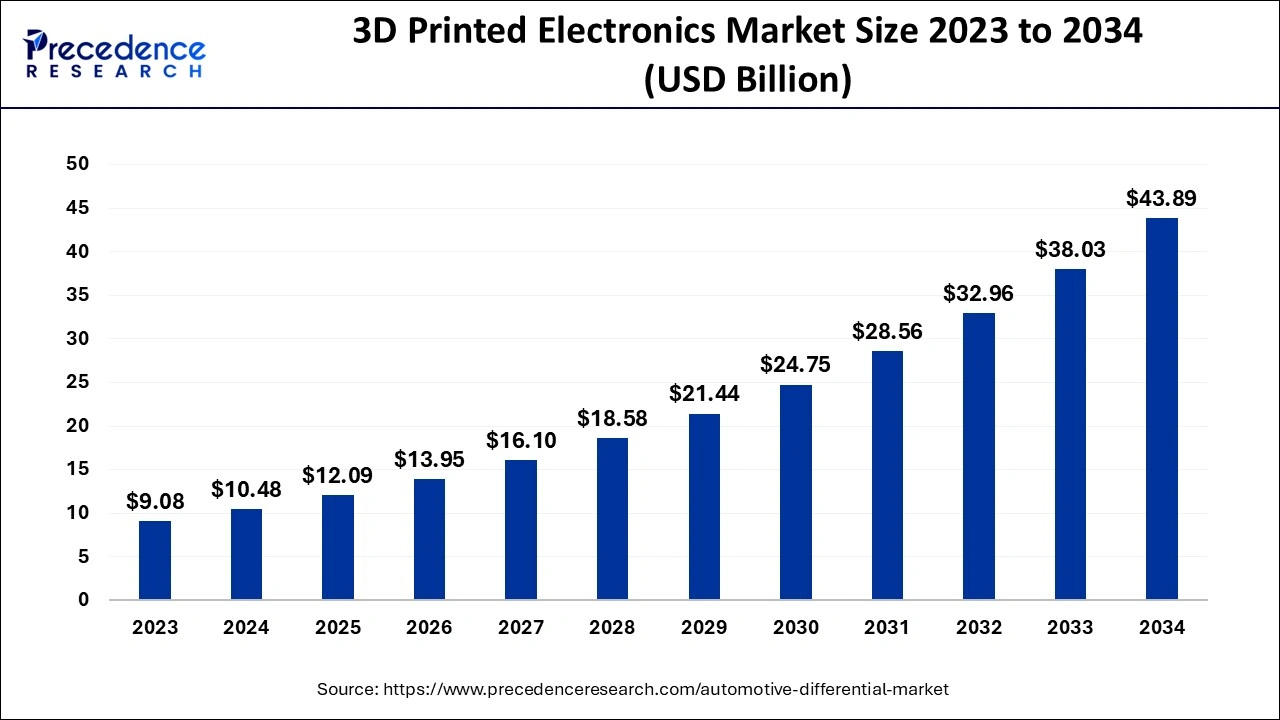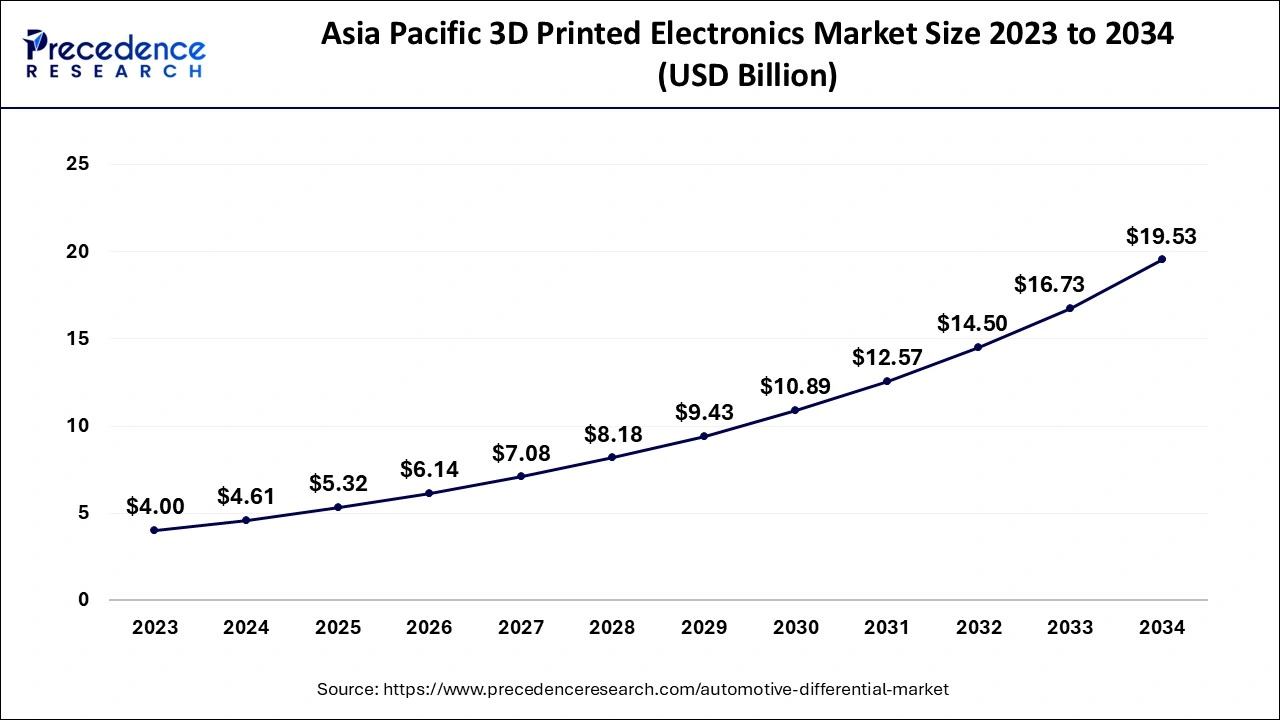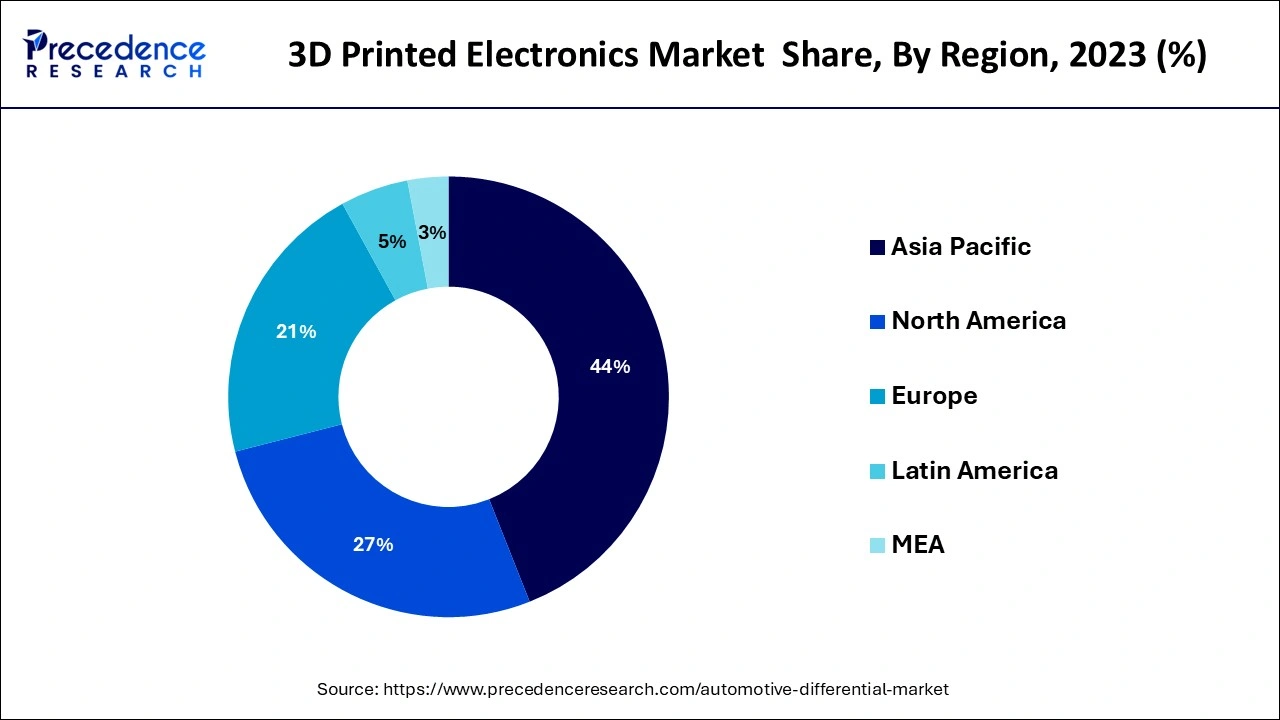March 2025
The global 3D printed electronics market size accounted for USD 10.48 billion in 2024, grew to USD 12.09 billion in 2025 and is predicted to surpass around USD 43.89 billion by 2034, representing a healthy CAGR of 15.40% between 2024 and 2034.
The global 3D printed electronics market size is accounted for USD 10.48 billion in 2024 and is anticipated to reach around USD 43.89 billion by 2034, growing at a CAGR of 15.40% from 2024 to 2034.

The Asia Pacific 3D printed electronics market size is evaluated at USD 4.61 billion in 2024 and is predicted to be worth around USD 19.53 billion by 2034, rising at a CAGR of 15.51% from 2024 to 2034.

Segmentation of 3D printing electronics based on the geography involves Asia Pacific to hold the largest share of 3D electronics market with increased developments and manufacturing and production of the new technologies with improved performance of the printing technologies with increased demands from the consumers helps to boost the market growth of printed electronics with 3D technology with increased research and development expanded the market growth at a larger extent with increased investment and key market players. Other regions included such as North America, Europe, Latin America, Middle East and Africa also help to drive the market of 3D printing electronics with increased growth rate.

Increased growth of the 3D printed electronics market in various sectors and industries with increased technologies over internet of things are the driving factors pf 3D printed electronics market which extended the market of 3D printed electronics to greater extent. Electronics system integrated with in the gadgets which allows the programming and functioning. Increased focus of 3D printing by using the antennas utilizing connectivity for 3D printed electronics products. With improved techniques and technologies in the 3D printed electronics involves processing of the electronics build components, and material creation and building the complex structure from the number of materials with developed techniques. With increased manufacturing developments and rising production by customizing the parts of the 3D printed electronics required to asset the part in to the electronic component based on the computerized system.
The Increased demand for the machines thinner, tinier machines with improved functions and developments in the 3D printed electronics. Impact of covid-19 affected the market growth which led to decreased production of 3D printed electronics and declined the market revenue share. Wide spread of corona virus across the various regions with imposed rules and regulations and shut down of the nation led to close down of the industries which decreased manufacturing of the 3D printed electronics components.
Faced the challenges for the sale of the 3D printed electronics and manufacturing in the year 2020 and later on solved the issues with developing situation and increased the market growth with increasing demands from the consumers. Electronics gadgets such as cameras, mobiles and number of elements integrated with the electronics systems.
Increased manufacturing of the products with low weight, ease of application with improved technology in manufacturing of the electrical components which enhance the market. Enhanced production of the antenna printings, and sensor printings in the 3D form which fuel the market. Rapid acceptance of the newly developed technology in number of sectors and increased demands from the consumers in industries such as health sector, defense, health sector, telecommunication, automobile industry, electrification system, energy utilities, aerospace and other many more industries expected to thrive the market of 3D printed electronics market with increased competition due to the availability of the new arrivals and increased performance. Increased market players with increased investment in the electronics and automobile industry have increased the market rate with increased research and development strives to grow the market during the forecast period.
| Report Coverage | Details |
| Market Size in 2024 | USD 10.48 Billion |
| Market Size by 2034 | USD 43.89 Billion |
| Growth Rate from 2024 to 2034 | CAGR of 15.40% |
| Base Year | 2023 |
| Forecast Period | 2024 to 2034 |
| Segments Covered | Printing Technology, Material, Resolution, Applications, End Use Industry, Transport Techniques, and Geography |
Increased utilization of the 3D printed electronics in the automobile industry widely end-use industry in the 3D printed electronics widely used in the industry with increased features. Increased features such as thinness, flexible, robustness other features such as touch control technique and improved surfaces with increased technologies in the car interior designer. The key market players involved in the 3D printed electronics with new innovation and technologies developed in the 3D printed electronics market with wide demand from the consumers and increased market rate of 3D printed electronics during the forecast period.
Increased automobile sectors with new manufacturing and developments in the electronic devices includes displays based on OLED, vehicles included with lighting. In automobile industry with wide utilization in displays, touch, sensors, lighting of the monitors. Utilization of sensors, monitor display, lights and many more in the transport automobile industry. Expansion of the 3D printed electronics market in the automobile industry with increased developments and demands strives the market to grow.
3D printing electronics with different techniques available for printing with wide applications of printing technology in the industries. Possessing different factors regarding the selection while printing includes such as selection of material and selection of substrate, selection of the printing pattern, Integrating the hardware design and developed software with new technologies integrated in the system software for developing the 3D printings. Challenging task for integration of the sensors, displays, embedded monitors, circuits, other electrification system involved for integration in to the circuit plays a major task during the utilization of the 3D printing electronic techniques with wide developments.
3D printed electronics with the improved facilities such as ease of availability, reduced cost of the printing techniques, improved displays, developed sensors, labels are the improved functions in the 3D electronics market.
Increased applications of 3D electronics printing in the health sectors with increased developments of displays, sensors, sounds, connectors and servers with wide demand from the market which helps to boost the market growth. Continuous research and development in the 3D electronics printing with new variations in electronics printing with new improved functions. Printing electronics utilized at home for image printing of the lungs with improved efficacy and market growth. Thin batteries involved in electronic device integrated in the printed plays a major role in the health care sector utilized in medical devices.
Emerging of the under developed nations with the increase developments and innovations and rising demands and continuous new research have increased the demand and strive the market growth.
Segmentation of 3D printing electronics based on the printing technology divided in to Ink jet printing includes such as continuous ink jet printing, drop on demand inkjet printing involves Thermal drop on demand inkjet printer, piezo drop on demand ink jet printing, electrostatic drop on demand ink jet printing. Screen printing involves flatbed screen printing, rotary screen printing, flexographic printer, gravure printing, and other such as aerosol printing, reel to reel printing, offset printing, pneumatic printing and many more. Screen printing to be widely used in printings of electronic circuit boards, posters, signage board, sensors, batteries and many more with developed manufacturing and new technologies.
Segmentation of 3D printing electronics based on the materials divided in to different sections such as Inks includes conductive inks involves conductive silver inks, conductive copper inks, transparent conductive inks, silver copper inks, carbon inks, dielectric inks and other inks. Substrate involves organic substrates such as polymers includes polyimides, polyethylene naphtholate, polyethylene terephthalate, papers include polyacrylate, polystyrene, polyvinylpyrrolidone, polyvinyl alcohol. Inorganic substrates involve such as glass and other such as metal and silicon oxides. Ink printers which to be at the top position with increased revenue share and increased the market rate.
Segmentation of 3D printing electronics based on the applications involves such as batteries, RFID tags, displays includes such as E-paper display electrochromic displays, electrophoretic displays, other E- paper display. Electroluminescent displays involve such as OLED displays, flexible OLED displays, LCD. Increased utilization in photovoltaic cells includes sensors, touch sensors, gas sensors, humidity sensors, pressure sensors, image sensors, temperature sensors and others. Lighting involves such as electroluminescent lighting, organic light emitting diode lighting and other applications.
Segmentation of 3D printing electronics based on the end use industry includes automobile and transportation, healthcare, consumer electronics, aerospace and defense, construction and architecture, retail and packaging and other end use industries.
By Printing Technology
By Material
By Resolution
By Applications
By End Use Industry
By Transport Techniques
By Geography
For inquiries regarding discounts, bulk purchases, or customization requests, please contact us at sales@precedenceresearch.com
No cookie-cutter, only authentic analysis – take the 1st step to become a Precedence Research client
March 2025
January 2025
June 2024
April 2023